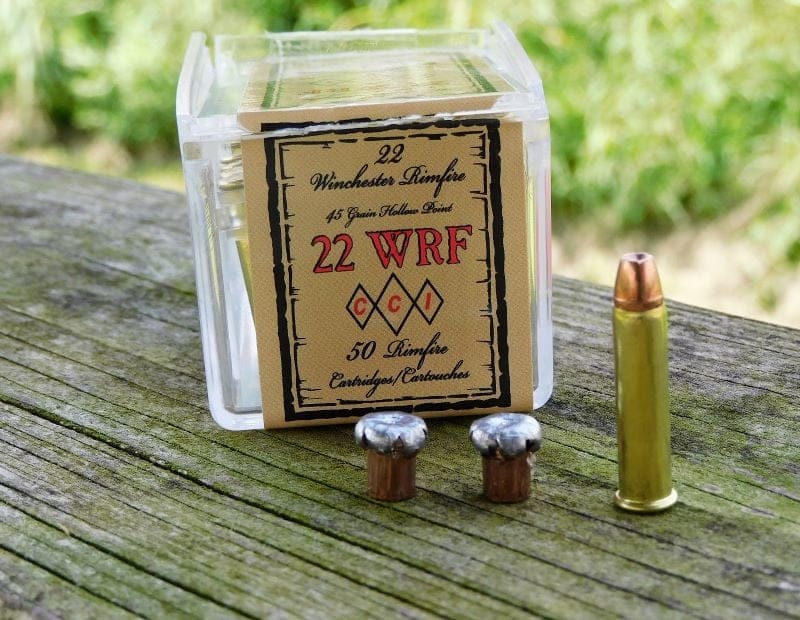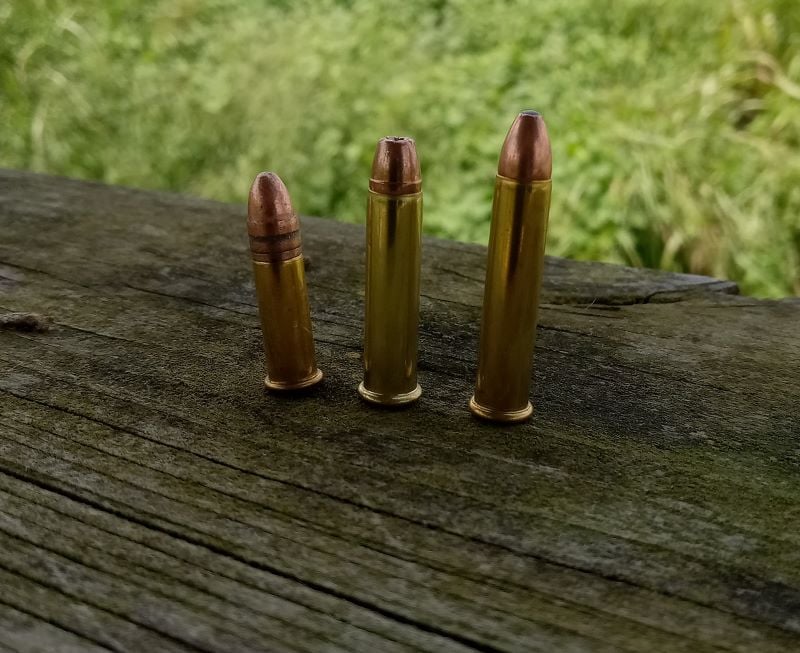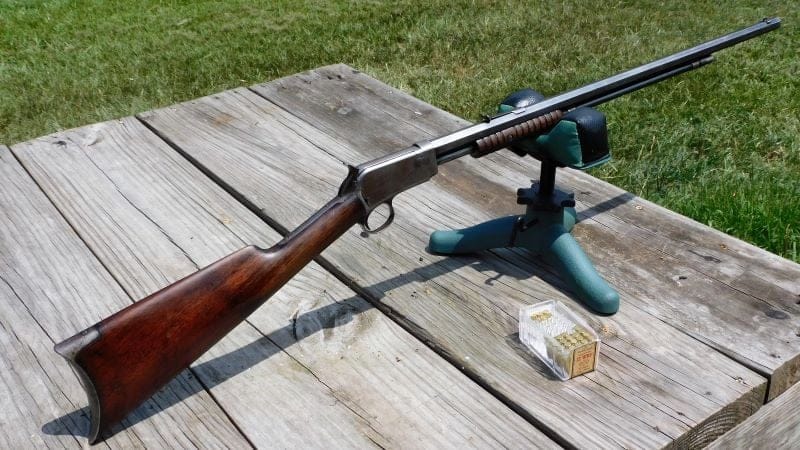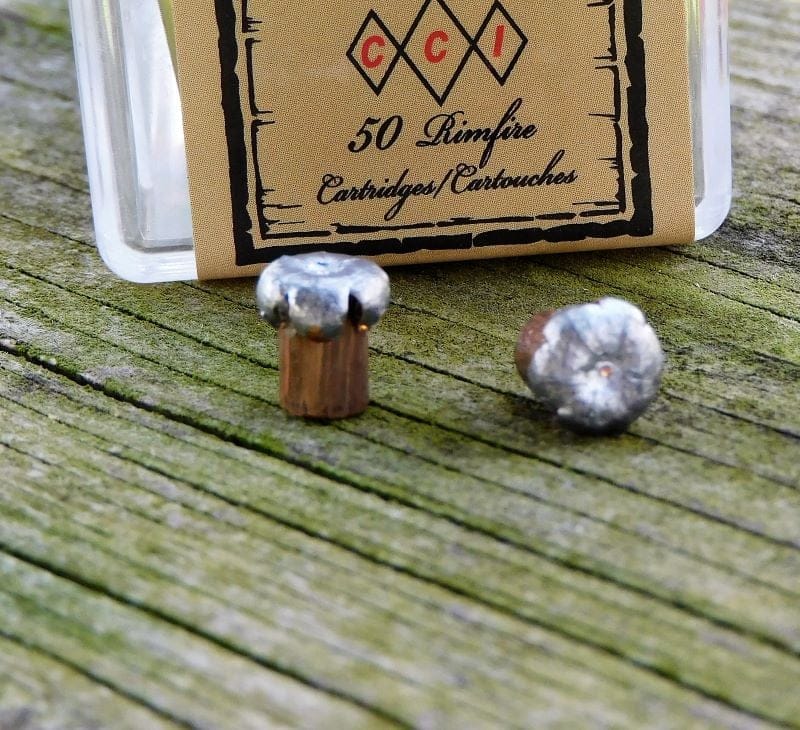In my humble opinion, every gun owner should own a firearm chambered in .22 rimfire. Perhaps the most popular round made today is the .22 Long Rifle cartridge. It is cheap, available, and there are plenty of firearms, both new and old, to shoot them. The .22 Long Rifle’s low noise, low recoil, and adequate ballistics make it an ideal choice for small game hunting and suppressed shooting. Its small size and low pressures also make it ideal for concealed carry pistols of truly tiny proportions. But the .22 Long Rifle is not the only .22 round out there. The .22 Short, .22 Long, and .22 Magnum rounds are still popular, although their utility has waxed and waned and waxed again over the years. There are other .22 rounds that we have never heard of that simply did not take off. Lost in between these extremes is the .22 Winchester Rimfire, or .22 WRF, cartridge.

The Origins of the .22 WRF
To understand the .22 WRF, we need to understand the mini arms race that was the world of .22 rimfire rounds in the late 19th century. The .22 Short has the distinction of being the first self-contained cartridge used in a firearm on the American market. It was developed in 1857 for the Smith & Wesson No.1 revolver. This tiny cartridge had a stubby case loaded with four grains of black powder topped with a 29-grain lead-heeled bullet. That round was lucky to reach 700 feet per second, but it was useful for pest control and popular for concealed carry. It was not powerful, but it was a proof of concept and the modern cartridge was here to stay.
Attempts to improve on the .22 Short carried on. The .22 Long came out in 1871 with a longer case, five grains of black powder, and the same 29-grain bullet. For varmint control and personal protection, it was better, but not by much. In 1880, the 22 Extra Long was introduced with an even longer case and more powder. That round used a 40-grain bullet. In a feat of originality, the makers of the .22 Long Rifle did not make the .22 Extra Long extra long. Instead, the .22 Long Rifle, as it came out in 1887, used the same 40-grain heeled bullet from the Extra Long, but stuffed on top of a Long case.
As shocking as it might seem today, the .22 LR did not take off in popularity for some years and the market was still hungry for a cartridge that had more killing power than what existed. In 1890, the Winchester Repeating Arms Company, famed for their lever action rifles, announced their first pump action rifle chambered in a new cartridge, the .22 Winchester Rimfire.
The .22 WRF: A Ballistic Profile
Like the .22 Long Rifle, the .22 WRF round is primed at the rim of the brass case. It has a case length of .945 inches, compared to the .22 LR’s .612 inches. The case was longer and held more powder than either the .22 LR or .22 Extra Long. On top of it, the .22 WRF uses a 45-grain non-heeled bullet. The .22 LR’s .220 inch diameter bullet is crimped at a smaller diameter heel and the rest of the bullet is flush with the case. The heeled bullet could easily be dislodged or collect lint and grit into its exposed lubrication grooves. The .22 WRF’s .224-inch bullet is uniform in shape and is crimped like a conventional round today.
The .22 WRF was celebrated as flatter shooting and more decisive on larger varmints than the .22 LR and its predecessors. The standard .22 LR load at the time used a 40-grain bullet traveling at 1080 feet per second (like the standard velocity loads marketed today) while the .22 WRF’s 45-grain bullet burned at 1450 feet per second.
The .22 WRF debuted alongside the Winchester Model 1890 pump action rifle and was associated with the 1890, 1906, and Model 61 pump action rifles that Winchester produced until 1963. But it was also available in other pump action and some bolt action rifles of all types including Stevens as well as Remington, who made their own ammunition for the .22 WRF, renaming it the .22 Remington Special rather than giving their competitor some free marketing. The .22 WRF was also available as a factory offering in revolvers like the Colt Police Positive, but it remained a round mostly associated with rifles.
The Demise of the .22 WRF
In the 1911 edition of “Hunter, Trader, Trapper” the editor unpacked the different available .22 caliber rifle cartridges and their advantages over one another. On the subject of the .22 WRF, the round “appears to give the same ballistic figures as the .22 Long rifle, judging from the catalogs, however, it is to have a little higher velocity and anyway its flat point bullet makes it a better killer. It compares favorable with the long rifle’s cartridge in accuracy and penetration is a little better. ”
Judging by this, the .22 WRF seemed marginally better for the jobs the .22 LR could still accomplish. To make matters worse, .22 WRF firearms could not accept other cartridges. While a 22 LR rifle could fit and fire the 22 Long or 22 Short. The .22 WRF did have the additional advantage of being cleaner to shoot and cleaner when stowed away in a shooter’s pocket because of its non-heeled bullet, but it was also more expensive to buy.
Still, the cartridge had its fans, particularly when shooting larger varmint animals. An article in the 1918 edition of “Outdoorsman” espoused the .22 WRF’s superior killing power that was used to effect on deer-sized game, even bears in a pinch. But in 1930, Remington introduced the first high velocity .22 LR load. This was the first of many loads that warmed the Long Rifle round to over 1200 feet per second, narrowing the ballistic gap with the WRF.

WRF sales languished during the Great Depression, but the round remained in the Winchester and Remington catalogs into the early 1960s, when another round came onto the scene to displace it entirely. That round is the 22 Winchester Magnum, confusingly labeled the .22 WMR.
The .22 WMR is not to be confused with the WRF. It was introduced in 1959 and it featured a longer WRF case with more powder and an identical non-heeled bullet. It is far more powerful than the WRF and the round has since grown in popularity in the hunting and self-defense community in a way the old WRF did not.
The .22 WRF in Review
The .22 WRF was a hot rod of its time, but the niches it filled are now occupied by rifles and handguns using high-velocity .22 LR and .22 Magnum ammunition. It came as a surprise at once when I accidentally purchased .22 WRF ammunition, thinking it was .22 WMR. But to my surprise, it fired in my .22 Magnum guns without issue and with good accuracy. Later, I found out that the .22 WRF has the same case and bullet diameter, but is only a tenth of an inch shorter and can be fired in firearms chambered for the longer round.
I was even more surprised to learn that any manufacturer still made .22 WRF. But CCI continues to produce a 45-grain hollow-point load. Winchester also makes occasional runs of their 45-grain lead-flat point load. The reason why makes perfect sense. There are many old guns out there and people want to shoot them. That keeps rounds like .32 S&W and .25 ACP in the market. The same is true for the .22 WRF. But are there any other compelling reasons to shoot the .22 WRF aside from keeping geezer guns in service? To answer that question, I decided tp pick up one of my bucket list rifles, a Winchester 1890. I picked the version in .22 WRF, found some CCI ammunition, and headed to the range to do some mythmaking and some mythbusting.

In the hand, the .22 WRF cartridge is hard to differentiate from the .22 Magnum, but you will not mistake the difference in report. Out of my Winchester 1890 with a 24-inch octagonal barrel, the CCI load has a sonic crack from the muzzle, but compared to a .22 Magnum, it is quieter and has less muzzle flash. It felt like shooting a rifle chambered in .22 LR, but with a bit more noise, and more energy on some swinging eight-inch plates I set up for target practice.
The .22 WRF is fun to shoot and only a few dollars more in price per box over the .22 Magnum. But how powerful is it? I set up my Caldwell Chronograph and stepped off 10 yards. I fired five rounds of the WRF over the chronograph. The CCI load clocked in at 1382 feet per second. That is about 500 feet per second slower than conventional 40-grain .22 Magnum ammunition. It is still well ahead of .22 LR high-velocity loads and is only equaled by 40-grain hypervelocity loads like the CCI Velocitor and the Winchester HyperSpeed. But the bullet design of the WRF is a higher quality jacketed hollow-point bullet.

Judging by its velocity, the WRF appears to be a middle-of-the-road load that does not shine in the way its competition did, then and now. But I did wonder how the WRF’s jacketed hollow-point bullet would fair against what I have seen from the .22 LR and the .22 Magnum. To put that to the test, I set up two blocks of 10% Clear Ballistics gelatin blocks. I left both blocks bare and stepped back to 10 yards. I fired three rounds into the blocks and came away surprised.

My first shot favored high and penetrated all 18 inches of gelatin blocks. Two rounds hit lower and both of these projectiles were captured, with excellent expansion, at 15½ inches. In terms of penetration, this .22 WRF load penetrated greater than most common .22 LR and .22 Magnum hollow-point loads on the market. .22 LR high-velocity rounds like the CCI Mini Mag and CCI Velocitor tend to stop at nine inches in the same medium. .22 Magnum loads like the CCI Maxi Mag can hit 12 inches.
In terms of wound damage, the WRF created straight wound channels and noteworthy ¾-inch puckering and stretching in the first six inches of penetration in gelation. The amount of damage is more than .22 LR and close to what a .22 Magnum non-expanding round would accomplish, yet it penetrated further. In reviewing the damage of the .22 WRF, I gained the impression that the lower velocity of the round prevented massive energy dump and fragmentation of the projectile, which is often the case with the all-lead .22 LR and the higher-velocity .22 Magnum. This allowed the WRF to punch well above its weight and outperform both.

Although the .22 WRF is mostly a round for old guns, those old guns can still punch. After shooting the round and seeing what it could do, I also got the impression that the .22 WRF would make an excellent meat-hunting load for the hunter equipped with a .22 Magnum rifle, where conventional Magnum loads would leave too little left to eat. That was, after all, why the .22 WRF came into existence in the first place.

